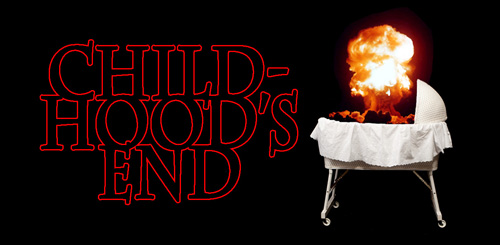
Oh, the cozy amber-tinted memories of youth. A simpler time of simpler tastes. As the cynical, crushing weight of adulthood often sends us nostalgically yearning to revisit the things we once held dear, we tend to find that those special things are not quite how we left them. Like a favorite climbing tree’s branches that we once had to leap for, now boringly coming up waist-high, the films we adored as children and tweens typically do not measure up the same now. Sometimes old favorites are best left to our memory. Yet now and then they miraculously hold up, or even prove to have hidden subtext we never realized. They say you can’t go home again, but I think it is high time that I tried.
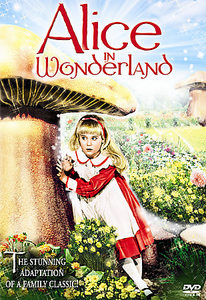 The Artifact: Alice in Wonderland (1985)
The Artifact: Alice in Wonderland (1985)
What Is It: TV mini-series.
The Backstory: Irwin Allen was the master, or at least foremost purveyor, of the high-concept Hollywood epic — overblown melodramas stuffed near bursting with movie stars and notable celebs. Films like The Towering Inferno and The Poseidon Adventure. He is said to have been baffled by the success of Star Wars, because despite that title, it had no stars in it. Allen also dabbled quite extensively in television; probably best remembered for Lost In Space. As one of his last projects (he retired in 1986, passed away in 1991), he wanted to do a lavish and star-studded adaption of Lewis Carroll’s two Alice novels, Alice’s Adventures in Wonderland and Through the Looking-Glass. So he did. And he got comedy legend Steve Allen (no relation) to pen the mini-series’ copious number of songs. Alice in Wonderland aired in its two parts on CBS, December 9 and December 10, 1985.
The Memory: My main memories of this adaptation are terror related. Little kids are scared pretty easily, and though I loved monsters and horror-themed material from my earliest breaths, I was no different from any other kid during my pupal stage. It wasn’t until around junior high that my fear receptors started getting calloused. Though I was scared often and routinely by frightening films, TV programs, and books, there are about a dozen things that terrified me so deeply to my core that I can still vividly remember the emotions now. One of those things was the Jabberwocky from this mini-series. It is an emotionally expressionist memory, but I can still very clearly see what the Jabberwocky looked like, how it moved, how young Alice happily opened a present in a dining hall, only for the Jabberwocky to improbably rise up out of the small box and chase her around a mansion. But the horror didn’t end there. When the Jabberwocky wasn’t scaring the ever-loving shit out of me, the rest of the mini-series was creeping me the fuck out. Which in a way was worse. I liked being scared. Especially by monsters. I didn’t like being unsettled, and there was a lot about Alice in Wonderland that unsettled me in ways I couldn’t really understand. In particular I remember Carol Channing making increasingly awful sounds and then turning into a sheep. And in a different scene, a baby turning into a pig or something. I also recall being aware that everyone in the film was famous, but recognizing almost none of them.
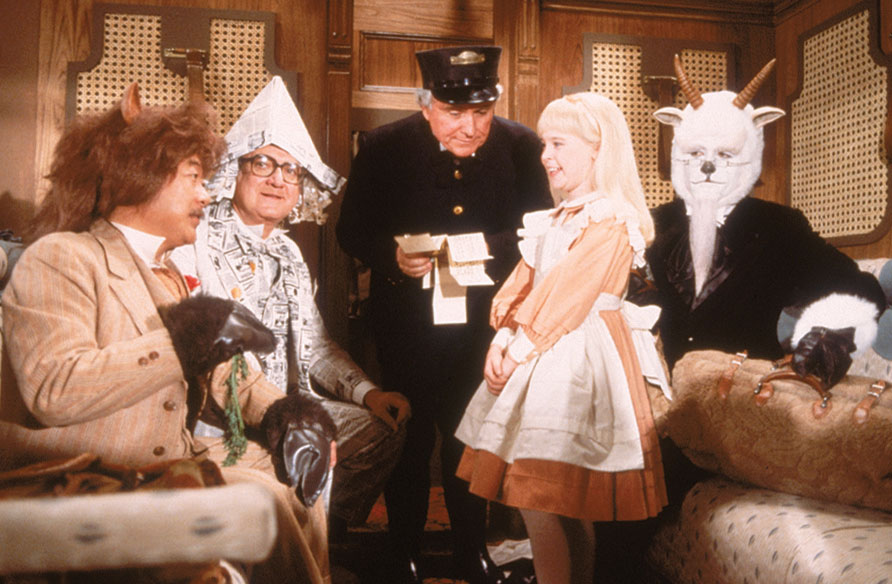
L to R: that's Pat Morita, Steve Allen, Merv Griffin, and Step By Step's Patrick Duffy.
How Long Has It Been: Not since the late 80’s.
The Reality: Let’s not beat around the bush. This is what the Jabberwocky looks like…
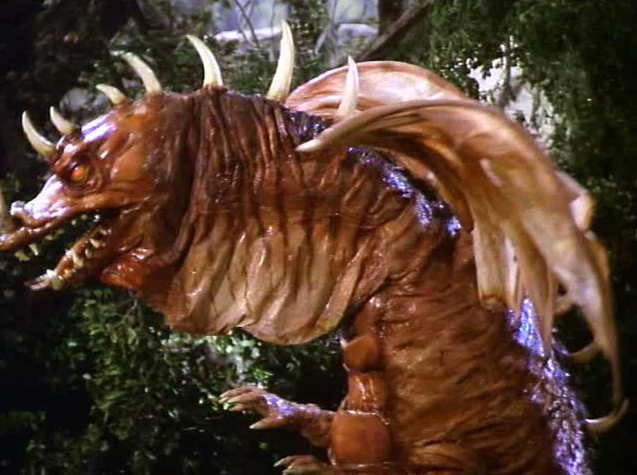
Oh, memory, you vixen. I am fascinated with how crappy the Jabberwocky actually looks. To be clear, I quite expected it to look crappy; that isn’t the source of my fascination. What is so utterly fascinating to me is — that is exactly how I remember the Jabberwocky looking! The creature’s shape, coloring, features, stumpy little arms, all that jazz was accurately etched into my memory. If I had drawn a profile picture of it before sitting down to rewatch the mini-series, I would have come eerily close in my accuracy. Of course, back in 1985, my under-developed mind was so flushed with fear that I couldn’t absorb how comically junky the damn thing looked. Now, watching the Jabberwocky shamble around like some shitty Godzilla foe, I really couldn’t hold back the laughter. To think, all those agonizing nights I lied awake in bed as a kid, waiting for sleep to mercifully claim me, as my lil’ imagination involuntarily invented graphic fantasies of the Jabberwocky stalking into my room. All because of this stupid looking thing!
Anyhoo. In another 25 years my primary memory of Alice in Wonderland will no longer be how terrifying the Jabberwocky is, but how crushingly boring the experience was. I’m sure the mini-series (which is a relatively faithful adaptation of the books) plays differently when spread out over two different evenings with the intended commercial breaks effecting the pacing, but strung together as one massive 3-hour film, calling it a “slog” doesn’t quite cover it. Representative of a bygone era of television, the problem with Alice on DVD is that it doesn’t even feel like a film, and I mean that to include TV films too. Aside from the rarest of examples, the staging, sets, and costumes all have the air of an old variety show sketch, shot with a three camera set-up. Many of the scenes easily could have been shot live in front of an audience. And though some of the costumes at least feature some minimal facial prosthetics (like Patrick Duffy’s above pictured goat), many of the guest stars look as if they’re wearing an adult Halloween costume, with their unpainted faces contrastingly protruding out (like Sammy Davis Jr’s caterpillar, pictured below). There is an undeniably quaint charm to all this, but it got incredibly old for me after the first half hour. And then there were two and half hours more movie!
I think I could have easily stomached, or even enjoyed, the intentionally half-assed presentation in Alice, were it not for two major factors: 1) the musical numbers, and 2) Natalie Gregory as Alice. While it was a little grueling watching dialogue scene after dialogue scene blocked, staged, and shot like a filmed Broadway performance, I think eventually my disconnection would have corrected itself had the musical numbers not been so lazy. The stagey presentation of Alice can be called a stylistic choice. The musical numbers can’t be called anything but lazy. Steve Allen’s songs range from blah-to-rather fun, and while there are no standouts, they are mostly all pleasant tunes. But pretty much without exception, none of the scenes in which characters are singing deserve to be called “musical numbers.” Most of the numbers feature only two or three characters, Alice and whichever celebrity guest stars are singing the song. The blocking in these scenes is very gawky and almost feels like director Harry Harris forced the actors to block it themselves 30-minutes before the cameras rolled. So Alice just stands there, wide-eyed and enthralled, as the guest star either stands in place crooning (bobbing and swaying to the beat) or meanders around Alice in a circle, then inevitably finishing things off by dropping into a pose as though he/she had just completed the big finish to some impressive dance routine. The movie is wall-to-wall guest stars, with Alice episodically encountering one after another, and almost every guest star sings. So we’re treated to an endless string of these torturous “numbers.” That said, it is always a treat to hear Telly Savalas (as the Cheshire Cat) sing, in any circumstance.
I honestly hate bashing child actors. For one thing, they’re just kids, and for another, they are often thrust into the profession by crazy parents. But I can’t properly critique Alice without talking about Alice. And Natalie Gregory (who replaced Poltergeist‘s Heather O’Rourke when she dropped out over money issues) is, well, kind of insufferable. Even more so than the embarrassing musical numbers, she is what wore me down the most as I braved through the mini-series. It isn’t entirely her fault (again, she’s just a kid doing her best). The role called for her to be constantly talking to herself, giving inane exposition on her thoughts, feelings, and reactions. While this is standard for Alice adaptations (the books are much the same), it takes a delicate touch to pull of a hero thinking out loud. There is no delicate touch here. The character of Alice is just annoying. Very, very annoying.
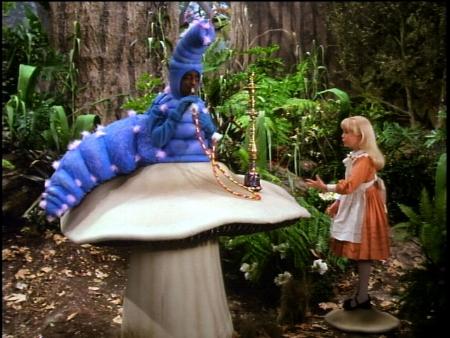
I believe it was the weird staginess of Alice that I found unsettling as a child. Everything just seems a bit off. Even though the entire production is very blatantly shot on sound stages, every scene is lit as though under an overcast sky — a very strange choice that makes everything feel in keeping with dreary ol’ England, but doesn’t add a lot of wonder to Wonderland. And the half-assed nature of many of the costumes can actually be a little creepy at times; Savalas’ Cheshire Cat kinda seems like a child molester in a furry getup. Carol Channing is still a bit horrifying though, to be honest. I had no clue who she was when I was a kid (I still don’t, really), but her raspy baby-talk voice is fucking weird, and though the “special effect” of her turning into a sheep is simply a dissolve, just the fact that Carol Channing starts making sheep noises in that heinous voice of hers is hair-raising. Even now.
Only The Player rivals this beast when it comes to a sheer accumulation of celebrity cameos. Just to name some of the cavalcade of guest stars I haven’t already mentioned: Scott Baio, Red Buttons, Sid Caesar, Sherman Hemsley, Roddy McDowall, Imogene Coca, Ringo Starr, Shelley Winters, Ernest Borgnine, Beau Bridges, Lloyd Bridges, Arte Johnson, Harvey Korman, Karl Malden, Donna Mills, John Stamos, Jack Warden, and Jonathan Winters are just some of the folks who toss on a costume. Though many of the stars in Alice have lost much of their luster in the passage of these nearly three decades, almost every single character is recognizable. It’s nuts. And sometimes fun. Wanna see Sid Caesar dressed as a giant bird farting around with Ringo dressed as a turtle? Here ya go. Everyone seems to be having a good time, which is always nice, though most of the celebs come and go without leaving much of an impression. Lloyd Bridges gives one of the few truly stand out performances, as the White Knight. Sammy Davis Jr is the only performer in Alice whose presence felt embarrassing to me. Not embarrassing in a “what are you doing in this film?” kind of way (the man had already done Cannonball Run II at this point), but because he’s Sammy Davis Jr the filmmakers clearly thought — we gotta make him tap dance! But with no real choreography, Davis Jr was left to just kinda tap around aimlessly on his old legs. Then he gives Alice a kiss at the end of the number. I realize it is a vintage Shirley Temple move for the adult dance partner to give his little girl costar a peck, but I call no bueno. Alice in Wonderland is already creepy enough when you know the backstory on Lewis Carroll’s, how shall we say, predilections, without having the strange adult males that Alice encounters in Wonderland literally kiss her.
Paradise Lost or Magic Reborn: Paradise lost. The film is an interesting time capsule of bygone celebrities and entertainers, but at 187 minutes it is simply too long and boring to engage adults beyond a certain nostalgia buffer zone. It works best as a curio now.
.
Previous Ruins Explored
The Ewok Adventure | The Care Bears Movie
Bedknobs and Broomsticks | The Land Before Time
Baby: Secret of the Lost Legend